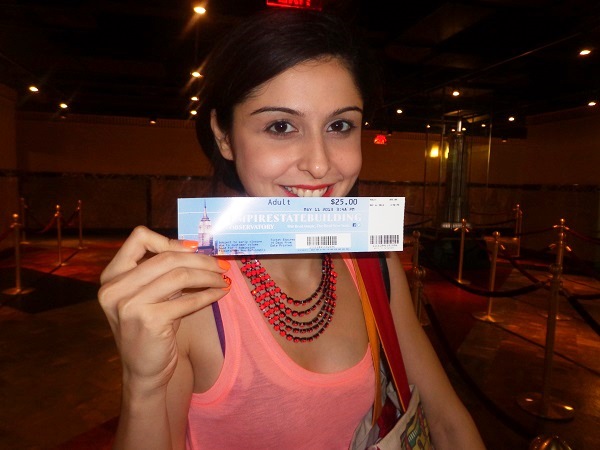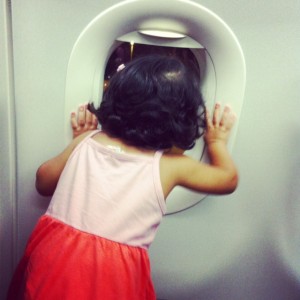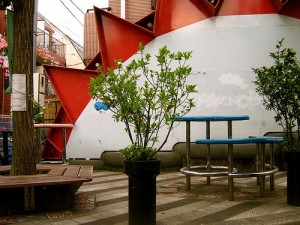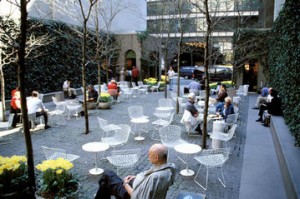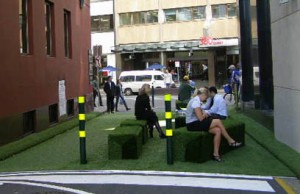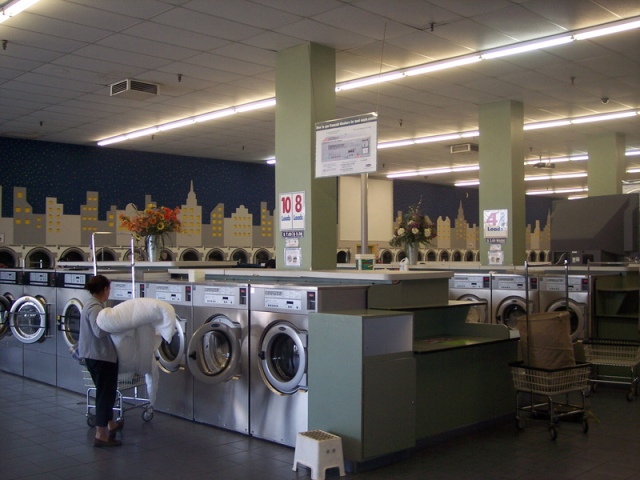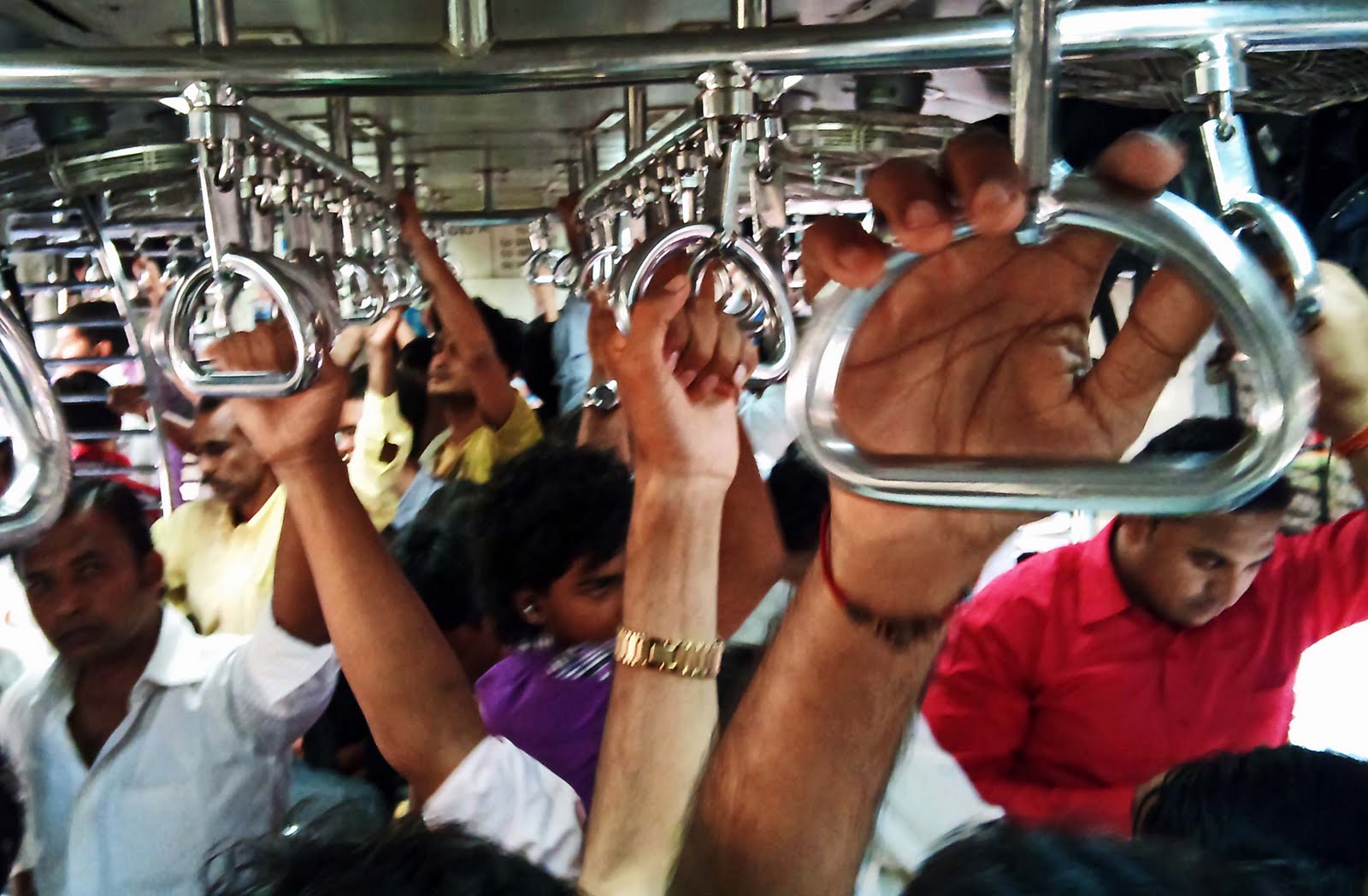Shweyta Mudgal talks about doing her own laundry in NY and why this chore is a record of our culture.
 The first apartment lease that I ever signed was for a large one-bedroom, pre-war (built before WWII) apartment, in a brownstone, in Astoria, Queens; one of five boroughs of New York City. The apartment was spacious and abundantly lit by the morning sun. It had a fire escape stair that doubled up as its own private make-shift balcony overlooking the quaint little backyard of an old Italian couple living next door.
The first apartment lease that I ever signed was for a large one-bedroom, pre-war (built before WWII) apartment, in a brownstone, in Astoria, Queens; one of five boroughs of New York City. The apartment was spacious and abundantly lit by the morning sun. It had a fire escape stair that doubled up as its own private make-shift balcony overlooking the quaint little backyard of an old Italian couple living next door.
Their backyard had a long clothesline slashed diagonally across itself, which worked on a noisy wheel pulley system, dispensing the line inch by inch to hang more clothes on until all its running length was consumed by wet laundry. Each morning, as I’d gulp down my coffee in a hurry to make my train in time, I’d hear the pulley creaking and knew the old lady was standing on her porch, ready to hang the day’s wash. Every evening when I’d come back home from work, I’d hear the same creaking again and I knew she was retracting the dried clothes off the line.
Almost as a daily ritual, she would press her nose into her dry sheets, as if inhaling some sort of scent, before pulling them down from the line into her laundry hamper.
I, of course, only did my laundry on weekends. As is the case with most pre-war buildings in the area, my lease contract specifically spelt out a ‘No washer/dryer’ clause, on grounds of wear and tear from too much soap on the 100-year-old pipes. Many buildings like mine discouraged residents from the same, worried about the stress the washing machines would exert on the building’s water infrastructure, the risk of leaks, water backlogging into bathtubs, etc. I was one of the many ‘private laundry-less’ tenants in NYC, who lugged our bags of dirty laundry to wash it in public laundromats. Whoever said, “Do not wash your dirty linen in public” was definitely not a New Yorker!
The Great Depression of the 1930s rendered private washing machines unaffordable in the US, hence steering Americans towards communal laundry practices. Self-service laundromats popped up all over the city, becoming integral elements of the New York cityscape. Even after the Great Depression, when washing machines found their way back into the list of ‘must-have appliances’ in American households, laundromats still remained indispensable for many a New Yorker. Most apartments (especially in Manhattan) were small, space being at a premium, and old buildings such as mine did not allow washers/dryers in homes, for reasons stated above.
 In that scenario, public laundromats provided a tremendous degree of convenience – of putting clean clothes within relative reach of anyone for a reasonable fee, thus achieving the level of social institutions in NYC.
In that scenario, public laundromats provided a tremendous degree of convenience – of putting clean clothes within relative reach of anyone for a reasonable fee, thus achieving the level of social institutions in NYC.
Many laundromats in the city stay open for 24 hours, conveniently accommodating even the most rigorous of work schedules. With their usual self-serve, coin-operated, washer/dryer facilities, they also offer a reasonably-priced wash-and-fold service, often with free pickup and delivery. For people who hate doing laundry (and most people I know fall in that category) this is a clear win-win! In an otherwise DIY (Do It Yourself) society, the comfort of having your laundry picked up, washed, folded in an impeccably professional fashion and delivered to your doorstep without causing a huge dent in your pocket, was nothing short of a blessing.
Yet, every weekend, I did my laundry myself in the laundromat located half a block from my place. I wasn’t ashamed to confess that I loved doing my own laundry. Having hardly ever done it in my life up until then, there was a novelty to this chore. It gave me a strange sense of rejuvenation and gratification, allowing me to completely immerse myself into the social fabric of my street.
My close friend, who was also my roommate at the time, and I did our laundry together at the laundromat. We would lug our dirty clothes in huge laundry bags armed with a few ‘quarters’ that had been collected in our common jar. After putting our clothes into the washers, inserting the appropriate number of coins and setting our desired wash-cycles, we would go run errands nearby for the next hour or so. Sometimes, a delay in getting back would find us staring down in frustration at our wet laundry that had already been unloaded by the next-in-line, impatient user.
Next, we would put our freshly-washed clothes into one of the humongous dryers with dryer sheets, set to our preferred drying option. Once again, the number of quarters inserted in the machines would determine the length of drying time. With another hour or so to kill, until the clothes would be dry and ready to fold, we would vamoose again for more errands. On our return, it was time to unload and fold the clothes on the communal folding tables next to other customers. Sometimes we would chat with them, at others we would watch the Spanish soap opera unfold its suspense on the TV while we neatly folded our clothes away.
The laundromat was its own little socio-cultural hub, bringing together neighbours living within a certain radius, all of who came from diverse cultural and professional backgrounds, to do a task as private as washing their laundry, together in public. It functioned as a storefront for various sales and purchases, lost and found, local community activities, greetings, exchanges and conversations, all of which took place through its public pin-up board. The Laundromat Project is a classic example of how laundromats have served as catalysts for change, empowering neighbourhoods and communities through art.
Unfortunately, the increasing gentrification of New York City has led to the slow disappearance of some of these neighbourhood laundromats. Escalated rents and other business chains are soon driving out these mom-and-pop-run businesses one by one from the city’s streetscape. Photographers/filmmakers such as the Snorri Brothers are trying to revive this dying institution by creating an awareness towards it through their photography book titled ‘Laundromat‘ which depicts facades of these dying breeds all across NYC.
The best part of doing one’s laundry as I did back then, was its quick turnaround time, thanks to the electric dryer. That, and the convenience aspect of it, were probably the only things it had going for itself. For one could easily point out the multiple disadvantages such as high energy bills, huge carbon footprints, reduced lifespan of clothing, overheating leading to duller looking fabrics, and shrinkage. This is perhaps why, while both washers and dryers can be considered luxury appliances in most parts of the world, the idea of using a washer has been more globally acceptable than that of a dryer.
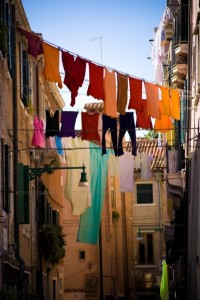 Motivated by environmental concerns and skyrocketing energy costs, American and Canadian consumers are re-evaluating their drying habits. In some communities here, outdoor clotheslines have been banned for years, on account of being eyesores that risk the prospect of driving down real estate value. This ordinance is now being challenged and overturned by members of a loose global network of people, rallying around the “right to dry”. ‘Project Laundry List‘ is a nonprofit that has helped to fight anti-clothesline ordinances in many North American neighborhoods, often by passing city or state legislation that invalidates such ordinances. Websites such as www.right2dry.org go as far as to instigate even the First Family of the US to line dry their clothes occasionally on the White House lawn, so as to help set an example for all Americans to go this energy-independent route.
Motivated by environmental concerns and skyrocketing energy costs, American and Canadian consumers are re-evaluating their drying habits. In some communities here, outdoor clotheslines have been banned for years, on account of being eyesores that risk the prospect of driving down real estate value. This ordinance is now being challenged and overturned by members of a loose global network of people, rallying around the “right to dry”. ‘Project Laundry List‘ is a nonprofit that has helped to fight anti-clothesline ordinances in many North American neighborhoods, often by passing city or state legislation that invalidates such ordinances. Websites such as www.right2dry.org go as far as to instigate even the First Family of the US to line dry their clothes occasionally on the White House lawn, so as to help set an example for all Americans to go this energy-independent route.
In this battle of the ‘energy-efficient’ system v/s the ‘time-efficient’ one, while there is no clear winner yet, one can argue that the latter definitely appeals more to city dwellers who are forever trying to find the 25th hour in their day. Most New Yorkers would still prefer going the washer/dryer way and getting the job done in a couple of hours, as against going the manual way and turning it into a two-day affair. For starters, they don’t have the time (to wait for their laundry to air-dry) nor the space (to hang it). It is not unheard-of among Americans to own two-to-three weeks worth of undergarments just so they could space out their laundry days a bit further.
In most other countries where it is culturally and climatically possible to dry one’s laundry outdoors, electric dryers are popular only in the upper middle/higher class of society. In fact, it is the lack of appliances such as these that creates urban poetry; making clotheslines into an inseparable part of the urban landscape. Laundry hung on clotheslines has reached the status of unsung wonder, as in the case of Venice, Italy for example. Here, one finds plenty of tourists, artists and professional photographers walking around sketching or snapping pictures of laundry, elevating this otherwise mundane yet universal phenomenon, considered an essential chore by many, into great works of art.
Laundry hung outdoors speaks volumes – it tells stories of people’s lives, their tastes and habits. It can be used as an exploratory tool into anthropology across cultures, as is done by New York-based photographer Sivan Askayo’s long term project titled ‘Intimacy under the wires‘. To quote from her personal site, “This project reveals images of laundry both intimate and unconfined while their snoopy character makes laundry, a seemingly prosaic subject, all that more intriguing.” So far, Askayo has traveled all over Tel Aviv, Jerusalem, Jaffa, Madrid, Barcelona, Florence, Venice, Buenos Aires and London, capturing pictures of clothing hung out to dry, standing under the lines, with her camera looking up at them.
Closer to home, one finds the dhobi ghats – the world’s largest outdoor laundry in Mumbai’s Mahalaxmi area, serving as a source  of inspiration to countless artists/filmmakers/researchers and photographers, who have spent long hours capturing scenes from the city’s open-air laundromat. Over the years it has become a must-visit sight on the bucket-list of many a tourist in this city. Rows of concrete wash-stones each fed individually through the intricately-woven plumbing network on this site, offer up an interesting analogy with modern-day office cubes that are wired similarly for laptops, phones and personal computers. For over 150 years now, the service of picking up dirty laundry, washing it and returning it neatly pressed, has been carried out here, for a small fee.
of inspiration to countless artists/filmmakers/researchers and photographers, who have spent long hours capturing scenes from the city’s open-air laundromat. Over the years it has become a must-visit sight on the bucket-list of many a tourist in this city. Rows of concrete wash-stones each fed individually through the intricately-woven plumbing network on this site, offer up an interesting analogy with modern-day office cubes that are wired similarly for laptops, phones and personal computers. For over 150 years now, the service of picking up dirty laundry, washing it and returning it neatly pressed, has been carried out here, for a small fee.
The dhobi’s modern-day fears have evolved on two grounds – the first being that India’s economic growth has brought disposable income into many households, making it feasible for them to own their own washing machines, thus rendering the dhobi redundant; the second being that the dhobi ghat occupies prime land in south Mumbai which could potentially be bought by developers to make way for luxury flats, depriving this age-old trade of its livelihood.
Laundry done Singaporean-style can also add a new leaf in the chapter of global line-drying. For starters, here, the term ‘clothes-line’ has a new meaning and a form, too. It is called a ‘gala’, which can essentially be described as a multicoloured pole that sticks out of apartment windows, usually at 90 degrees to the facade, over which damp clothes are pinned down using cloth pegs or pins. Traditional Singaporeans employ a ‘teko’, a naturally sturdy bamboo pole that serves the purpose equally well.
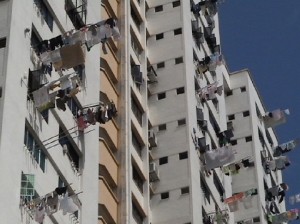 Scores of such poles with wet fluttering clothes on them, jutting out of tiny windows of most Singaporean HDB (Housing and Development Board) high-rises, make the building facades appear like a huge concrete porcupine of sorts. Not only are they aesthetically unappealing but there is also a chance that, if not anchored properly, they may come crashing down on unsuspecting pedestrians below. Due to the uncertainty in the Singaporean weather year-long, these poles can be retracted to dry clothes indoors, as well.
Scores of such poles with wet fluttering clothes on them, jutting out of tiny windows of most Singaporean HDB (Housing and Development Board) high-rises, make the building facades appear like a huge concrete porcupine of sorts. Not only are they aesthetically unappealing but there is also a chance that, if not anchored properly, they may come crashing down on unsuspecting pedestrians below. Due to the uncertainty in the Singaporean weather year-long, these poles can be retracted to dry clothes indoors, as well.
In most other countries, exterior clotheslines of apartments are sensibly strung parallel to the length of the windows, like in India. Apartments in Mumbai often have clothes-lines strung indoors under the ceiling (in their kitchens or common passage areas) and outdoors below or sometimes over the window, for both indoor and/or outdoor drying as determined by the weather. Newer high profile apartments being built off late in the city come equipped with special concealed ‘drying areas’ that do not interfere with the aesthetics of the building, usually provided off of the ‘servants area’.
Evidently, much effort is made to conceal the public exhibitionism of laundry in certain cultures, where it is considered intrusive with the urban aesthetic, even though it makes for an integral act in daily housekeeping.
All that comes out in the wash after this laundry-talk, is that a routine, everyday task such as the act of doing laundry, studied across different cultures, ceases to be just a task any more. It offers itself up as a perfect example of a mundane activity with underlying meaning that has transcended to new heights in socio-political landscapes worldwide. It has often inspired the art world, shaken the political one and iconised the architectural one.
This simple act alone has caused consumers to re-think their conveniences and opt for greener solutions, governments to re-draft ordinances, it has been an unusual source of cultural insight to artists, and offered itself up as a brilliant case study for urban design. It has the power to bring together neighbours over a picket fence as much as in a public laundromat.
To some, it may be a source of endless boredom, but to others it brings a calming sense of quotidian liturgy. Come to think of it, I think I’ve cracked the code on why my old Italian neighbour smelt her sheets each time she picked them off the line in her yard – it was her way of soaking in the sun long after it was gone!
A Mumbaikar by birth and a New Yorker by choice, recently-turned global nomad Shweyta Mudgal is currently based out of Singapore. An airport designer by day, she moonlights as a writer. ‘Outside In’ is a weekly series of expat diaries, reflecting her perspective of life and travel, from the outside-in. She blogs at www.shweyta.blogspot.com and is at the receiving end of much envy from her American friends off late for hardly being able to remember the last time she did her own laundry!
(Pictures courtesy tropicalisland.de, foothillappliance.com, blogs.mtvswitch.org, bugbitten.com)
 She’s anything but just a pretty face – a lawyer by qualification, a model by profession (she started modelling at age 16) and a marathon runner by choice, Scherezade Shroff was recently selected to represent India as part of Sunsilk Style Studio, an initiative in which Sunsilk flew 20 international bloggers to New York in May 2013.
She’s anything but just a pretty face – a lawyer by qualification, a model by profession (she started modelling at age 16) and a marathon runner by choice, Scherezade Shroff was recently selected to represent India as part of Sunsilk Style Studio, an initiative in which Sunsilk flew 20 international bloggers to New York in May 2013. itself was designed to be fun, with a party theme and lots of fun props like blow-up cupcakes and an actual photo booth,” she said. “It didn’t seem like a photo shoot at all. But before it began, many of the girls came to me asking for tips on facing the camera. Yet once it got underway, despite the cameras, everybody had a blast! It was very relaxed and I think it was the funnest shoot I’ve ever been a part of,” she laughs.
itself was designed to be fun, with a party theme and lots of fun props like blow-up cupcakes and an actual photo booth,” she said. “It didn’t seem like a photo shoot at all. But before it began, many of the girls came to me asking for tips on facing the camera. Yet once it got underway, despite the cameras, everybody had a blast! It was very relaxed and I think it was the funnest shoot I’ve ever been a part of,” she laughs.